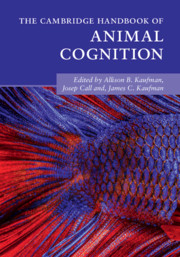Book contents
- The Cambridge Handbook of Animal Cognition
- The Cambridge Handbook of Animal Cognition
- Copyright page
- Dedication
- Contents
- Figures, Tables, and Boxes
- Contributors
- Acknowledgments
- Introduction
- Part I Communication and Language
- Part II Memory and Recall
- Part III Social Cognition
- 11 Social Cognition Overview
- 12 Proximate and Ultimate Mechanisms of Cooperation in Fishes
- 13 Evolutionary and Neural Bases of the Sense of Animacy
- 14 Raven Social Cognition and Behavior
- 15 Reciprocal cooperation – Norway rats (Rattus norvegicus) as an example
- 16 Exploring the Social Minds of Elephants
- 17 Dolphin Social Cognition
- 18 Mirror Self-Recognition
- Part IV Social Learning and Teaching
- Part V Numerical and Quantitative Abilities
- Part VI Innovation and Problem-Solving
- Index
- References
14 - Raven Social Cognition and Behavior
from Part III - Social Cognition
Published online by Cambridge University Press: 01 July 2021
- The Cambridge Handbook of Animal Cognition
- The Cambridge Handbook of Animal Cognition
- Copyright page
- Dedication
- Contents
- Figures, Tables, and Boxes
- Contributors
- Acknowledgments
- Introduction
- Part I Communication and Language
- Part II Memory and Recall
- Part III Social Cognition
- 11 Social Cognition Overview
- 12 Proximate and Ultimate Mechanisms of Cooperation in Fishes
- 13 Evolutionary and Neural Bases of the Sense of Animacy
- 14 Raven Social Cognition and Behavior
- 15 Reciprocal cooperation – Norway rats (Rattus norvegicus) as an example
- 16 Exploring the Social Minds of Elephants
- 17 Dolphin Social Cognition
- 18 Mirror Self-Recognition
- Part IV Social Learning and Teaching
- Part V Numerical and Quantitative Abilities
- Part VI Innovation and Problem-Solving
- Index
- References
Summary
The social intelligence hypothesis states that a complex social life is cognitively challenging and thus a driving force for mental evolution. Support for the hypothesis comes mainly from studies on primates, and more recently also from birds, specifically corvids. In this paper, I review what is known about the socio-cognitive skills of common ravens, a corvid species that has been intensively studied over the past twenty-five years. The findings show that temporary foraging groups are composed of individuals with different degrees of familiarity and structured by different types of social relationships. Familiar ravens show profound knowledge about their own and others’ relationships, and they appear to use this knowledge selectively and strategically in cooperative and competitive settings. The studies on ravens may thus inform our understanding of what constitutes social complexity and which cognitive skills are selected for.
- Type
- Chapter
- Information
- The Cambridge Handbook of Animal Cognition , pp. 322 - 342Publisher: Cambridge University PressPrint publication year: 2021



